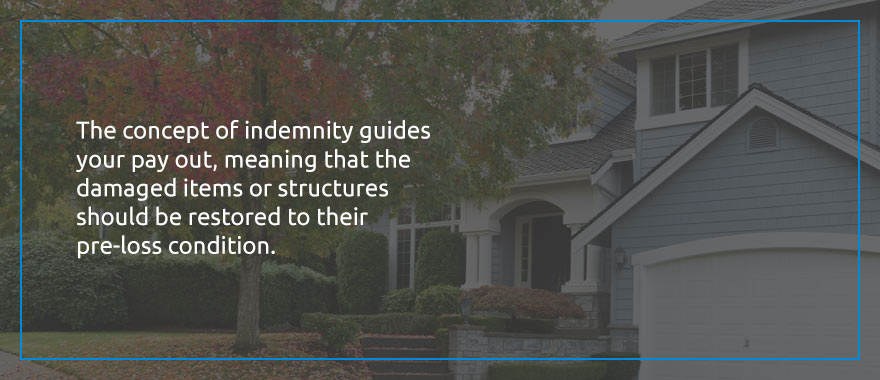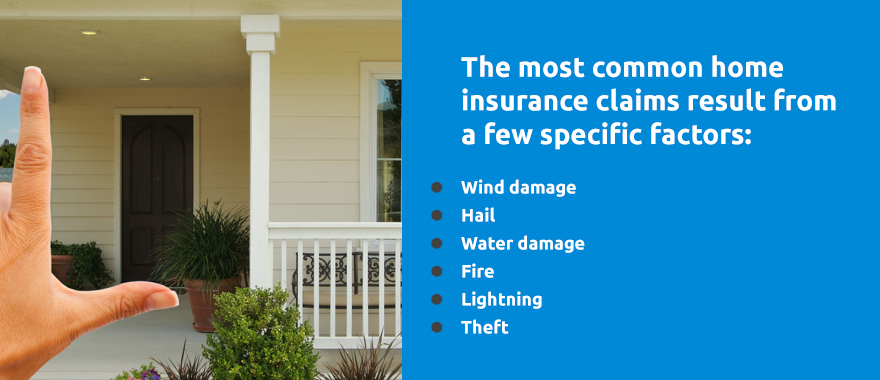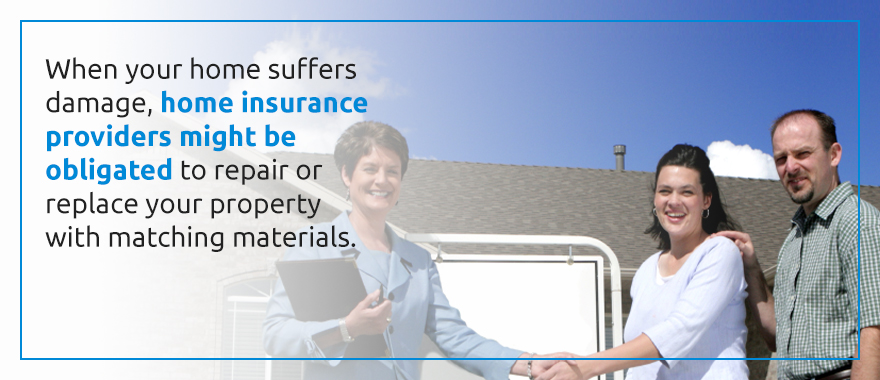
When your home suffers damage from a significant event such as a fire or flooding, your first worry might be about the safety of your family and pets. In the moment, you probably aren’t thinking about the lengthy process of filing a claim with your homeowners insurance. When the dust settles, you probably start to think, “How are we going to pay for all of this?”
Fortunately, homeowners insurance helps in a variety of situations, especially for damage due to natural disasters and accidents. During worse-case scenarios, an accident or disaster may even prevent you from staying in your home until the necessary repairs can be completed. Contacting your insurance company as soon as possible can help streamline the process for you and your family.
If you already have or are shopping for homeowners insurance, it’s important to know about the relevant homeowners insurance laws. Below, you can learn all about matching line-of-sight laws and rules and how they relate to insurance matching regulations in your state.
The term “matching line of sight” is one you might hear or read about as you review your policy. If your home has suffered damage and you’re looking into your policy to file a claim, pay close attention to any language that references a line of sight.
In most contexts, “line of sight” means an area in your field of vision. If someone describes an area as “having a good line of sight,” they likely mean it has a good vantage point to see a particular area or activity. For insurance, line of sight takes on a slightly more complex meaning.
When your home suffers damage for which you can make a homeowners insurance claim, such as a disaster or accident, your insurance company will send someone called an adjuster to your home. This person’s job is to inspect the damage and ask you questions about the incident. Then, they’ll determine how much the insurance company should pay out.
The concept of indemnity guides your payout, meaning that the damaged items or structures should be restored to their pre-loss condition. When discussing repairs, line of sight states everything within a person’s line of sight should have a reasonably uniform appearance. So, a section of cracked white tiles should be repaired with identical white tiles.
However, issues arise when contractors can’t find identical or matching materials to conform with the original condition of the item or structure. In the case of old houses or antique pieces, finding a match can be especially difficult. If you can’t find a suitably matching replacement, the line of sight rule dictates that the whole area in the line of sight must get a replacement.

Fortunately, line of sight covers both the interior and exterior of your home. So, if you have damage to your roof that led to internal damage like dents and scratches to your hardwood floors, line of sight coverage would potentially cover both areas. In addition to roofs and floors, line of sight covers other things, including:
To understand line of sight coverage, let’s look at a few examples based on type and area of damage.
If a fire damages your kitchen, it might impact a variety of surfaces and items. Assuming it doesn’t spread to other parts of the house, you’ll still be facing a long list of damages. For instance, your walls will need repainting and you’ll likely have to fully replace your stove, oven, backsplash and anything else in the fire’s reach.
Here, line of sight would dictate that the backsplash and appliances should be replaced with matching models, and the paint should match the rest of the house. If you aren’t able to find a suitable alternative, the remaining items would have to be replaced so they match throughout the whole kitchen.
If you have an unfinished basement and you’re impacted by flooding from especially heavy rain, line of sight would apply only in the sense that the repairs should get your basement back to its original condition. If you have a finished basement, line of sight coverage would be similar to any other room of the house. The paint, flooring, furniture and appliances would all be repaired or replaced to their original condition.
If a tree fell on a part of your house that had a covered, screened-in porch, damage to the porch roof, exterior siding and windows should be repaired to match the rest of the house. If for any reason the manufacturer has discontinued the particular type of siding you have on your house, all of that siding within the line of sight should be repaired. This might mean you replace the front siding with a matching color, while the back of the house retains its original siding. Whether insurance must match siding varies by state. Many require replacing all siding if a reasonable match isn’t found. It’s best to check your policy and state laws to understand your matching rights.

The most common home insurance claims result from a few specific factors:
As such, the most common repairs for line of sight coverage are to roofs, floors and walls. Barring old or discontinued products, finding matching materials to repair these areas of the house is relatively easy. Difficulties in matching materials come with furniture and other more unique home structures.
When looking through your homeowners insurance policy or preparing to make a claim, you may come across the term “cosmetic damage.” What’s the difference between cosmetic damage and other damage?
If the damage to your home impairs the structure’s function — for example, hail happens to come through your roof to damage the underlayment — it’d qualify as functional damage. In contrast, cosmetic damage is significant damage that impacts the appearance of a home’s structure. If the hail merely causes dents to the metal gutters and misplaced granules, it’d qualify as cosmetic damage.
Another example of cosmetic damage might be when a fire causes discoloration to the ceiling without impacting its function. For important structures like a roof, cosmetic damage might still impinge on the roof’s stability, such as weakening the shingles and leading to more repairs in the future.
In terms of homeowners insurance coverage, cosmetic damage is a complicated topic. While some policies may cover cosmetic damage, others may not — and a few policies can cover specific instances of both. Pay close attention to your policy to determine whether it covers both functional and cosmetic damage.
The insurance adjuster will determine how to categorize the damage to your home. If we continue with our use of the roof example, many adjusters might determine that a few dents to a metal roof or misplaced granules to a shingled roof qualify as cosmetic damage. However, a roofing expert may contradict their findings, stating that the cosmetic damage will increase the risk of roof failure.
In that instance, the decision between no, partial and full roof replacement coverage can be tricky. Because roofs are among the most expensive home repairs, the decision for a full roof replacement shouldn’t be taken lightly — and the findings of many roofing professionals may be influenced by their commercial aspirations to sell roofs.
Still Unsure? Contact Us to Learn More

When your home suffers damage, home insurance providers might be obligated to repair or replace your property with matching materials. This way, the structure is restored to its original condition and has a uniform appearance. Pursuing matching coverage for home insurance is one of the most complex issues, as insurance companies and insured parties often disagree on whether an entire section of damaged property should be replaced to match everything.
In some policies, your insurance company may promise “like kind and quality” replacements. This stipulation in your policy would allow your insurance provider to replace structures and items with similar quality and composition. That said, that doesn’t mean the new materials will match your existing home aesthetics.
Whether your insurance company provides matching line of sight coverage depends on your policy and the state you live in. Some states have statutes and regulations that determine what exactly matching means and the requirements of the insurance company. The following states may require matching materials in homeowners claims:
For more information about specific legislation on matching line of sight coverage, consult your state’s specific laws or regulations. Among states that don’t have statutes or regulations that dictate what matching line of sight coverage means, some have case law precedents that define insurance terms to require matching in certain situations or to certain extents. These states include:
Missouri is a state that doesn’t have homeowners insurance law dictating how insurance companies should approach matching line of sight coverage. However, you’ll find case law precedent that guides how insurance companies should interpret language around matching line of sight.
In legal terminology, case law precedent refers to court cases that are considered authoritative. Therefore, the decision in said cases applies to other cases with similar facts or circumstances. Missouri’s matching line of sight coverage is informed by that rule of case law precedent.
In the case of Alessi v. Mid-Century Insurance Company, the homeowner argued that because the particular type of siding that was damaged by hail — a covered event — was no longer manufactured, the insurance company was obligated to replace the siding on the entire house. Though her policy called for “equivalent construction,” the insurance company contested that didn’t mean matching coverage.
This case’s initial decision was in favor of the insurance company. However, upon appeal, the homeowner won their case — the deciding factors were the homeowner’s higher premiums for their replacement cost policy, the legal definition of the word “equivalent” and the overall value of the property with and without mismatched siding.

As a result, Missouri has a case law precedent that informs its matching line of sight coverage. In the event matching materials aren’t available, the insurance company is usually required to replace the whole structure so all materials match. While not every claim has similar facts and circumstances, the precedent is a strong baseline for determining whether you qualify for matching replacement.
Take a close look at the specific language of your homeowners insurance policy to determine if and in what circumstances you may be covered for matching line of sight.
If your house suffers damage and you’re not sure whether your policy covers matching line of sight, you can look at a few terms to give you clues:
Be sure to learn the laws in your state. In the event you have to file a claim, become familiar with any case precedents that may relate to your circumstances. Additionally, be persistent and bring a strong argument when filing your claim and talking to the insurance adjuster. Take everything into context, from aesthetics to the long-term value of your home.
If you’re looking for a comprehensive homeowners insurance policy from a company you can trust, consider David Pope Insurance. As a local, family-owned insurance company, we stand apart from our competitors with our honest approach and our drive to continually improve. We benefit families by keeping insurance costs low while still giving you peace of mind that your items will be covered.
David Pope Insurance also offers policies for auto, commercial, renters and life insurance. Contact us today to learn more about the best policy for your situation.